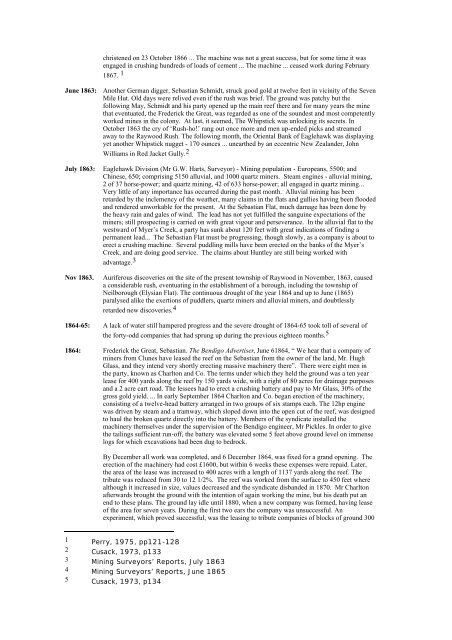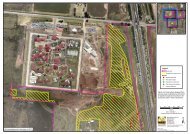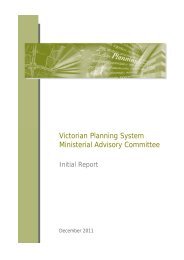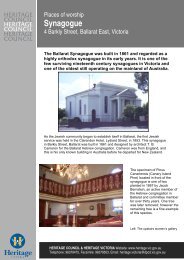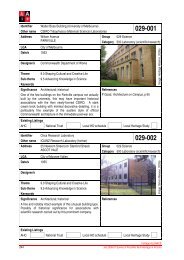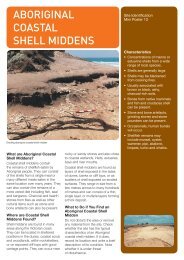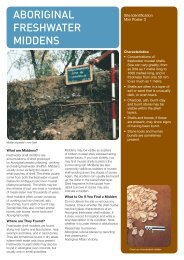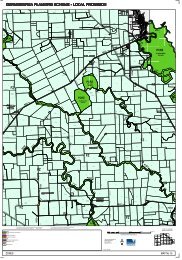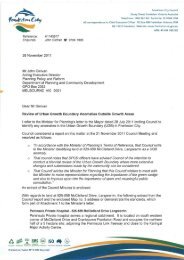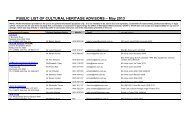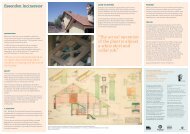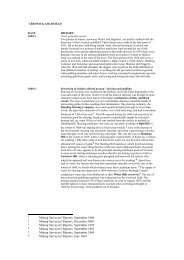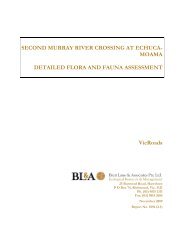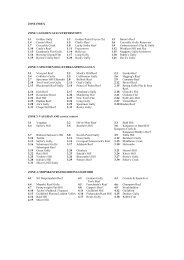Bendigo General History - Department of Planning and Community ...
Bendigo General History - Department of Planning and Community ...
Bendigo General History - Department of Planning and Community ...
You also want an ePaper? Increase the reach of your titles
YUMPU automatically turns print PDFs into web optimized ePapers that Google loves.
christened on 23 October 1866 ... The machine was not a great success, but for some time it was<br />
engaged in crushing hundreds <strong>of</strong> loads <strong>of</strong> cement ... The machine ... ceased work during February<br />
1867. 1<br />
June 1863: Another German digger, Sebastian Schmidt, struck good gold at twelve feet in vicinity <strong>of</strong> the Seven<br />
Mile Hut. Old days were relived even if the rush was brief. The ground was patchy but the<br />
following May, Schmidt <strong>and</strong> his party opened up the main reef there <strong>and</strong> for many years the mine<br />
that eventuated, the Frederick the Great, was regarded as one <strong>of</strong> the soundest <strong>and</strong> most competently<br />
worked mines in the colony. At last, it seemed, The Whipstick was unlocking its secrets. In<br />
October 1863 the cry <strong>of</strong> ‘Rush-ho!’ rang out once more <strong>and</strong> men up-ended picks <strong>and</strong> streamed<br />
away to the Raywood Rush. The following month, the Oriental Bank <strong>of</strong> Eaglehawk was displaying<br />
yet another Whipstick nugget - 170 ounces ... unearthed by an eccentric New Zeal<strong>and</strong>er, John<br />
Williams in Red Jacket Gully. 2<br />
July 1863: Eaglehawk Division (Mr G.W. Harts, Surveyor) - Mining population - Europeans, 5500; <strong>and</strong><br />
Chinese, 650; comprising 5150 alluvial, <strong>and</strong> 1000 quartz miners. Steam engines - alluvial mining,<br />
2 <strong>of</strong> 37 horse-power; <strong>and</strong> quartz mining, 42 <strong>of</strong> 633 horse-power; all engaged in quartz mining...<br />
Very little <strong>of</strong> any importance has occurred during the past month. Alluvial mining has been<br />
retarded by the inclemency <strong>of</strong> the weather, many claims in the flats <strong>and</strong> gullies having been flooded<br />
<strong>and</strong> rendered unworkable for the present. At the Sebastian Flat, much damage has been done by<br />
the heavy rain <strong>and</strong> gales <strong>of</strong> wind. The lead has not yet fulfilled the sanguine expectations <strong>of</strong> the<br />
miners; still prospecting is carried on with great vigour <strong>and</strong> perseverance. In the alluvial flat to the<br />
westward <strong>of</strong> Myer’s Creek, a party has sunk about 120 feet with great indications <strong>of</strong> finding a<br />
permanent lead... The Sebastian Flat must be progressing, though slowly, as a company is about to<br />
erect a crushing machine. Several puddling mills have been erected on the banks <strong>of</strong> the Myer’s<br />
Creek, <strong>and</strong> are doing good service. The claims about Huntley are still being worked with<br />
advantage. 3<br />
Nov 1863. Auriferous discoveries on the site <strong>of</strong> the present township <strong>of</strong> Raywood in November, 1863, caused<br />
a considerable rush, eventuating in the establishment <strong>of</strong> a borough, including the township <strong>of</strong><br />
Neilborough (Elysian Flat). The continuous drought <strong>of</strong> the year 1864 <strong>and</strong> up to June (1865)<br />
paralysed alike the exertions <strong>of</strong> puddlers, quartz miners <strong>and</strong> alluvial miners, <strong>and</strong> doubtlessly<br />
retarded new discoveries. 4<br />
1864-65: A lack <strong>of</strong> water still hampered progress <strong>and</strong> the severe drought <strong>of</strong> 1864-65 took toll <strong>of</strong> several <strong>of</strong><br />
the forty-odd companies that had sprung up during the previous eighteen months. 5<br />
1864: Frederick the Great, Sebastian. The <strong>Bendigo</strong> Advertiser, June 61864, “ We hear that a company <strong>of</strong><br />
miners from Clunes have leased the reef on the Sebastian from the owner <strong>of</strong> the l<strong>and</strong>, Mr. Hugh<br />
Glass, <strong>and</strong> they intend very shortly erecting massive machinery there”. There were eight men in<br />
the party, known as Charlton <strong>and</strong> Co. The terms under which they held the ground was a ten year<br />
lease for 400 yards along the reef by 150 yards wide, with a right <strong>of</strong> 80 acres for drainage purposes<br />
<strong>and</strong> a 2 acre cart road. The lessees had to erect a crushing battery <strong>and</strong> pay to Mr Glass, 30% <strong>of</strong> the<br />
gross gold yield. ... In early September 1864 Charlton <strong>and</strong> Co. began erection <strong>of</strong> the machinery,<br />
consisting <strong>of</strong> a twelve-head battery arranged in two groups <strong>of</strong> six stamps each. The 12hp engine<br />
was driven by steam <strong>and</strong> a tramway, which sloped down into the open cut <strong>of</strong> the reef, was designed<br />
to haul the broken quartz directly into the battery. Members <strong>of</strong> the syndicate installed the<br />
machinery themselves under the supervision <strong>of</strong> the <strong>Bendigo</strong> engineer, Mr Pickles. In order to give<br />
the tailings sufficient run-<strong>of</strong>f, the battery was elevated some 5 feet above ground level on immense<br />
logs for which excavations had been dug to bedrock.<br />
By December all work was completed, <strong>and</strong> 6 December 1864, was fixed for a gr<strong>and</strong> opening. The<br />
erection <strong>of</strong> the machinery had cost £1600, but within 6 weeks these expenses were repaid. Later,<br />
the area <strong>of</strong> the lease was increased to 400 acres with a length <strong>of</strong> 1137 yards along the reef. The<br />
tribute was reduced from 30 to 12 1/2%. The reef was worked from the surface to 450 feet where<br />
although it increased in size, values decreased <strong>and</strong> the syndicate disb<strong>and</strong>ed in 1870. Mr Charlton<br />
afterwards brought the ground with the intention <strong>of</strong> again working the mine, but his death put an<br />
end to these plans. The ground lay idle until 1880, when a new company was formed, having lease<br />
<strong>of</strong> the area for seven years. During the first two ears the company was unsuccessful. An<br />
experiment, which proved successful, was the leasing to tribute companies <strong>of</strong> blocks <strong>of</strong> ground 300<br />
1 Perry, 1975, pp121-128<br />
2 Cusack, 1973, p133<br />
3 Mining Surveyors’ Reports, July 1863<br />
4 Mining Surveyors’ Reports, June 1865<br />
5 Cusack, 1973, p134


